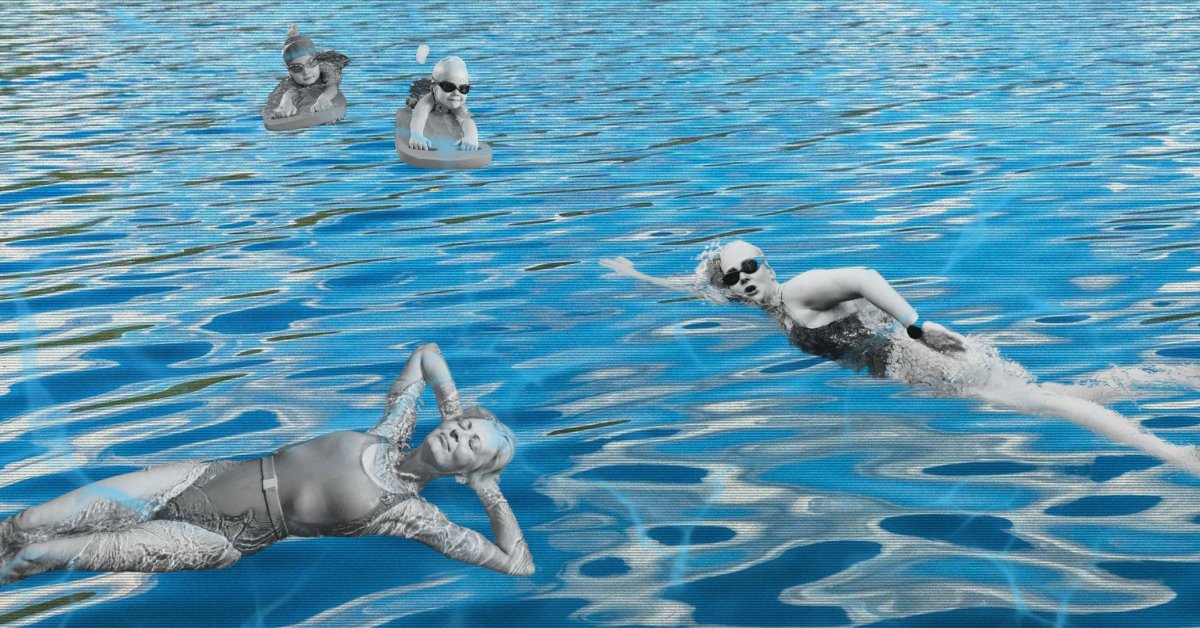That glistening swimming gap may look—and really feel—refreshing on a sweltering day. However writhing in ache from abdomen cramps, nausea, and vomiting? Staring on the rest room ceiling as an alternative of the blue, sunny sky? Not a lot.
Leaping into even the prettiest and clearest rivers, lakes, creeks, and different pure our bodies of water can expose you to a cesspool of disagreeable and invisible fellow swimmers—mostly micro organism, viruses, and parasites. “These germs are microscopic, so that you’re not going to have the ability to inform they’re there,” says Invoice Sullivan, a professor of microbiology and immunology on the Indiana College College of Drugs and creator of Happy to Meet Me: Genes, Germs, and the Curious Forces That Make Us Who We Are. “Swimming is a good, enjoyable exercise—don’t get me improper. However you do should be aware that there are risks that lurk on the market.”
That’s very true for sure individuals. In case you’re largely wholesome, you’ll fare higher than some; should you’re uncovered to micro organism or different nefarious germs, your physique ought to get well pretty efficiently. The individuals most inclined to extreme sickness are “the very younger, the very previous, and people with preexisting situations that weaken their immune system,” Sullivan says. “In case you’re in a type of susceptible populations, you must positively rethink swimming in questionable water.”
We requested specialists what threats could be lurking in your favourite swimming gap, and the way to keep secure.
The issue with inland water
Environmental scientists have a dependable means of monitoring the water high quality at widespread coastal seashores, usually by taking samples on a every day or weekly foundation. If micro organism ranges surpass a sure threshold, they submit an advisory on-line and put up indicators that warn swimmers the water could be contaminated. “The issue with inland places is that it’s exhausting to know the place persons are going to attempt to soar in,” says Rachel Noble, a professor within the Institute of Marine Science on the College of North Carolina who leads a laboratory that research micro organism and viral pathogens in leisure and different kinds of water. Somebody who’s kayaking at a neighborhood lake, for instance, may make their solution to a small island away from the principle swimming space and determine to dive in to chill off.
Learn Extra: The best way to Spend Time Exterior if You Hate Getting Sweaty
Nonetheless, assets exist. There’s knowledge obtainable for a lot of inland our bodies of water, although monitoring is much less frequent than at coastal spots. The place Noble lives in North Carolina, for instance, she will be able to pull up a leisure water high quality web site and evaluation knowledge—and a useful map—from the final week, six months, or 12 months. Each state has the same useful resource, she provides, and it’s a good suggestion to verify yours repeatedly.
The commonest well being threats
You may consider E. coli and Salmonella in relation to undercooked meat or tainted lettuce. However they’re additionally the likeliest kinds of micro organism you’ll encounter in a swimming gap, due to fecal contamination from people or, extra doubtless, animals, Sullivan says. Think about livestock grazing in a tributary that feeds into the lake you’re swimming in, for instance. All it takes is one heavy rainstorm to push their manure and animal waste into the water. “It washes downstream to the place individuals could be swimming,” he says. If you find yourself with E. coli or Salmonella, you may expertise doubtlessly extreme gastrointestinal signs—which typically get so dangerous, individuals land within the hospital with dehydration.
A micro organism referred to as Pseudomonas aeruginosa, in the meantime, causes swimmer’s ear, which might result in ear ache, swelling, and discharge. “It’s not a particularly harmful an infection, and typically it resolves by itself,” Sullivan says. “Generally a shot of antibiotics will clear it proper up, however it may nonetheless be a nuisance.”
Along with micro organism, rotavirus and norovirus may very well be lurking within the water. Each trigger “rapid-onset” diarrhea and vomiting, Sullivan says. Norovirus is especially contagious, he provides, and might survive exterior of the physique for one to 2 weeks. In case you get one among these viruses, your signs will doubtless final just a few depressing days.
Learn Extra: 10 Bizarre Signs That Would possibly Be Allergy symptoms
One other menace, parasites, could cause longer-lasting misery. Cryptosporidium, which is excreted by cows, generally contaminates pure our bodies of water—and should you get sick, you’ll expertise watery diarrhea, abdomen cramps, and vomiting. “In case you have any motive to consider that cattle are close to the physique of water you are swimming in, that may give me pause as as to whether I need to dip my toe into these waters,” Sullivan says. Giardia, which is shed within the feces of animals like beavers and muskrats, can also be frequent and results in comparable signs.
Sometimes, individuals want pharmaceutical help to get well from parasites, Sullivan says, however there aren’t as many remedies obtainable for Giardia as there are Cryptosporidium. “You’ve often simply gotta experience it out, and it’s a extremely disagreeable expertise that lasts about one to 2 weeks,” he says. Parasites are likely to linger, particularly should you’re immunocompromised—and along with the bodily signs, “there’s a psychological aspect, in that there are these creepy issues residing inside you,” he says.
Rarer however extra excessive dangers
You’ve in all probability seen headlines concerning the dramatic-sounding “brain-eating amoeba,” or Naegleria fowleri—a parasite present in heat freshwater. It might probably enter swimmers’ noses after which make its solution to their mind, inflicting an an infection referred to as main amebic meningoencephalitis that’s nearly all the time deadly. “It might probably really feel scary as a result of it is in all probability basically all over the place, nevertheless it doesn’t trigger illness fairly often,” says Dr. Daniel D. Rhoads, chair of the School of American Pathologists’ microbiology committee, and part head of microbiology on the Cleveland Clinic. “I am certain just about all of us have been uncovered to it, nevertheless it would not often trigger an issue as a result of it is bodily difficult to get all the best way into the mind simply from swimming in water.” When individuals do get contaminated, they nearly all the time die inside per week.
Learn Extra: How Properly Will You Age? Test Your Grip Power
In the meantime, world warming has precipitated a spike in “flesh-eating illness,” extra formally referred to as necrotizing fasciitis. It’s brought on by micro organism in saltwater or brackish water and eats away at tender tissue and muscle tissues. “What occurs is the micro organism get contained in the physique by means of a break within the pores and skin—some sort of wound,” Sullivan says. “As soon as it begins taking root, it occurs fairly rapidly. It causes excessive ache, and it seems prefer it’s consuming away on the flesh, however what’s actually occurring is the micro organism is destroying muscle and nerves beneath the wound.”
That forestalls your immune cells from reaching the location the place they might should be to battle the micro organism—and retains drugs from getting there, too. That’s why the most typical remedy is “both carving away the contaminated tissue and even amputating the limb,” Sullivan says.
The trail to an infection
The commonest means individuals swimming inland get sick is by swallowing the water. How a lot you devour issues: “In case you swallow only a teeny-tiny bit, you may have the ability to get away with it,” Sullivan says. “However should you swallow a great mouthful, there is a cheap probability that is sufficient to make you sick.”
Learn Extra: When to Go to the Emergency Room vs. Pressing Care
Conserving your head above water may help cut back the probability of gulping down germs. But it surely’s not foolproof. When individuals emerge from the water, their pores and skin could be lined with micro organism or viruses. The following factor you understand, they’re chowing down on a ham sandwich or passing round bottles of water, and people germs are hopping from individual to individual. That’s why you must all the time sanitize or wash your fingers with cleaning soap and water after swimming, Sullivan says; if potential, rinsing off in an outside bathe is a good suggestion, too.
When do you have to see a physician? In case you sense your gastrointestinal misery isn’t typical, when you have a excessive fever, in case your signs final past just a few days, or should you see blood in your diarrhea, schedule an appointment, Rhoads says.
The best way to keep secure
In case you’re decided to swim in a river or lake, there are some methods to make the expertise safer. Right here’s what specialists suggest.
Heed posted warnings
Take indicators about swimming dangers and potential contamination severely. “If any individual’s taking the time to supply well being steerage, it is value listening to it,” Rhoads says. Along with checking native water-quality studies, click on over to your vacation spot’s social-media account. Some parks, for instance, submit warnings concerning the water, particularly after extreme storms or if there’s been a sewage leak.
Use your entire senses
More often than not, the water you’re swimming in received’t have any noticeable indicators of what’s lurking beneath the floor. However should you do occur to detect a foul odor or discover a wierd shade within the water, keep out. Discoloration might point out “there’s discharge from a pipe or a close-by golf course,” Noble says. “In case you see quite a lot of cloudiness, or if a lake is in any other case clear blue and it seems brown and lined with algae, then the chances are there’s some type of runoff that is attending to that location,” she says. “The runoff can include issues that make you sick, so use your senses.”
Take note of the climate
The danger of an infection spikes within the aftermath of a storm. Heavy rain can wash every kind of contaminants into the water: canine waste from close by paths, particles, chemical substances, human sewage, and extra. It’s inconceivable to say precisely how lengthy the danger stays elevated, Noble says, as a result of many components affect it. However should you discover energetic runoff—or rainwater flowing throughout the land into the water—it’s greatest to remain on dry land.
Go for well-maintained areas
At all times do a sweep of the world the place you’re swimming to get a pulse on its cleanliness, Noble advises. Is there seen canine waste? Overflowing rubbish cans? “If the trash cans aren’t repeatedly emptied, you may get quite a lot of birds in them, and people birds will defecate,” she says. “Then that feces will make its means into the water.”
Learn Extra: What to Put on When It’s Actually Scorching Exterior
Whereas birds will naturally inhabit areas with swimming holes, poorly maintained rubbish disposal makes it extra doubtless they’ll congregate in excessive numbers, and that may have an effect on water high quality.
By no means drink the water
Whether or not you get thirsty kayaking down the river—or whilst you’re biking and occur to cross a pleasant stream—don’t drink the water, nonetheless tempting it could look. One of many basic case studies Rhoads hears about is individuals who noticed nice-looking water in a mountain stream and crammed up their water bottles—not realizing there have been beavers upstream going to the lavatory. Then, he says, they find yourself with a parasite.
Use ear plugs and nostril plugs
Carrying ear plugs whenever you swim may help defend you from the micro organism that causes swimmer’s ear. And nostril plugs (typically referred to as clips) act like “a clamp for the surface of the nostril,” Sullivan says, which might block water from getting into your nostrils. The U.S. Facilities for Illness Management and Prevention recommends using them to assist keep off critical an infection.
Don’t swim when you have open wounds
This may help defend you from flesh-eating micro organism, Sullivan says. You also needs to cowl any cuts, scrapes, or recent tattoos or piercings with a water-resistant bandage, he advises. Keep away from sharp objects whilst you’re swimming, too: “If there’s quite a lot of rocks or shells, and so they minimize you whilst you’re swimming, the flesh-eating micro organism can get into your physique that means.”


